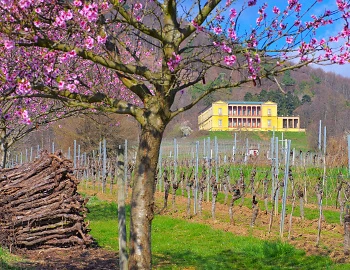Wachenheimer Riesling Auslese 2017
QbA Pfalz, Dr. Bürklin-Wolf, 375 ml

| Grape variety: | Riesling |
| Producer: | Dr. Bürklin-Wolf / Fam. Bürklin |
| Origin: | Germany / Pfalz / Wachenheim |
Description
This Riesling Auslese from Wachenheim impresses with its elegant body, its lively juiciness and its intense aromas of citrus peel and ripe mango, paired with a delicate sweetness.
Our head sommelier Marc Almert about the Wachenheimer Riesling Auslese
"Riesling was my first love..." My first position as a sommelier was in the Rheingau region, in the heart of one of the world's most historical regions for Riesling cultivation. Thus it will come as no surprise that you will always find a bottle of Riesling in my own private fridge. All the more reason for my belief that sweet wines in general, and Riesling Auslese in particular, really need to be championed. This harmonious balance of sweetness and tartness, coupled with an abundance of fruit and minerality, not only provides the perfect way to flatter your dessert but can also conjure up moments of pure bliss on its own. And when you add to your glass a historical family business, biodynamic cultivation and one of the best winemaking locations in the Mittelhaardt region, then, as far as I'm concerned, the result is perfect happiness!
Attributes
| Origin: | Germany / Pfalz / Wachenheim |
| Grape variety: | Riesling |
| Label: | Vegan, Certified organic or biodynamic wine |
| Ripening potential: | 3 to 12 years |
| Drinking temperature: | 12 to 14 °C |
| Food Pairing: | Hot Asian dishes, Goat's cheese, Giant crevettes, grilled langoustines, Hot vegetable curries |
| Vinification: | pressing the whole grape, fermentation in wooden barrel |
| Harvest: | hand-picking with simultaneous grape sel, strict selection |
| Maturation: | in steel tank |
| Bottling: | filtration |
| Volume: | 9.0 % |
| Note: | Contains sulphites |
Dr. Bürklin-Wolf / Fam. Bürklin
Riesling
The cold-weather king
The Riesling is the flagship of the German wine industry. It grows from north to south in all growing areas. It is also comfortable in the neighbouring Alsace region and in Austria. Its specialty is being vinified to a variety of degrees of sweetness, from bone-dry wines to ice wine. Moreover, thanks to its spirited acidity, it ages better than many reds. The typical Riesling smells of citrus, peach and apricot, shows hints of flint, and with maturity develops an idiosyncratic petrol note. It reflects its terroir like hardly any other white variety. Thus, it often gets fuller and more aromatic in Austria than in Germany. In Alsace, in turn, it has a particular mineral taste. Riesling is a wonderful culinary companion. It fits well not only with fish and shellfish, but also takes the heaviness from hearty meals. And with a fine sweetness and acidity balance, it works wonders for Asian cuisine.

Pfalz
Pfalz: Riesling meets Burgundy
Palatine winemakers manage the feat of vinifying top-tier crus from both white and red varieties. In addition, Riesling presents the same class here as Chardonnay and other Burgundy varieties. This versatility at high quality levels makes Germany’s second-largest wine region a trove of discoveries of all kinds. Tranquil winegrowing towns with a diverse range of culinary offerings and hotels make the Palatinate region a perfect wine travel destination.

Germany
Germany – Into the elite the hard way
Sitting in the heart of Europe, the hilly, lake-dotted landscape of Germany provides ideal, fertile soil for the most diverse vine varieties. From Albalonga to Zweigelt, over 140 different grape varieties are grown on about 100,000 acres, cared for by nearly 50,000 vintners. Most of these vintners are young, modern, internationally trained, inquisitive and urbane. It is hardly surprising, then, that German wine has a good reputation well beyond the country's borders.




